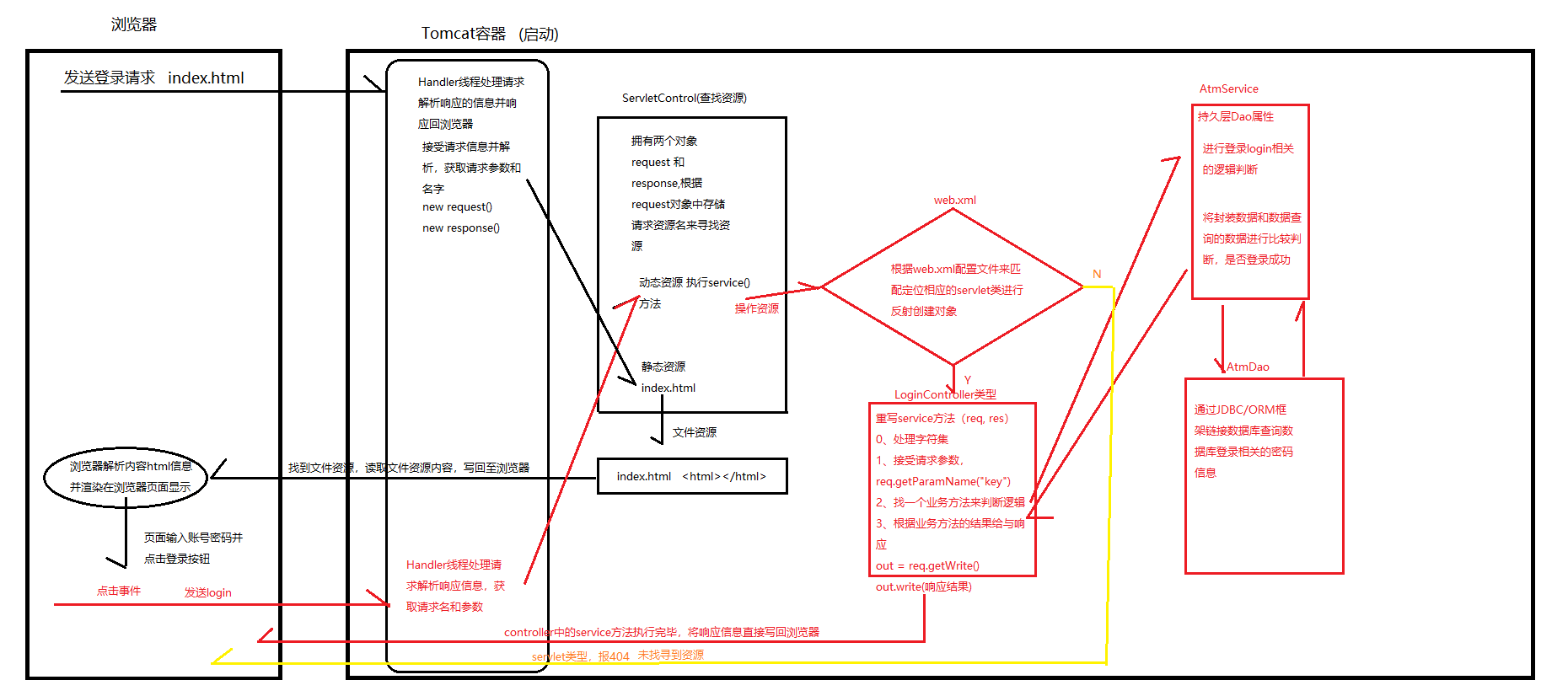一、什么是Servlet
简单的说,浏览器发出请求到tocat服务器,服务器就会初始化一个servlet实例(servlet采取生命托管的方式实现单例,不存在时才会创建实例),servlet示例会启动一个线程来处理该请求,并进行响应该请求,动态生成web内容
二、什么是Tomcat服务器
Tomcat是Apache开发的一种servlet容器,实现了对servlet和jsp等的支持,用来处理并响应浏览器发送过来的请求,实际上Tomcat是Apache 服务器的扩展,但运行时它是独立运行的,所以当你运行tomcat 时,它实际上作为一个与 Apache 独立的进程单独运行的。
三、web.xml配置文件解析
1 <servlet> 2 <!-- servlet的内部名称,自定义 --> 3 <servlet-name>login</servlet-name> 4 <!-- servlet的类全名:包名+类名 --> 5 <servlet-class>com.TestServlet.servlet.LoginServlet</servlet-class> 6 <!-- 当servlet对象立即加载时 url?后携带的重要信息, 在加载servlet类是可以直接加载进去 7 可以通过可以在init方法内使用带ServletConfig的参数读取 8 String value = config.getInitParameter("key");//某一个key对应的value 9 Enumeration en = config.getInitParameterNames();//获取全部的key 10 String name = config.getServletName();//获取当前Servlet类名 11 ServletContext application = config.getServletContext();//获取全局上下文对象 12 --> 13 <init-param> 14 <param-name>name1</param-name> 15 <param-value>value1</param-value> 16 <param-name>name2</param-name> 17 <param-value>value2</param-value> 18 </init-param> 19 <!-- servlet对象创建优先级 --> 20 <load-on-startup>1</load-on-startup> 21 </servlet> 22 <!-- servlet的映射配置 --> 23 <servlet-mapping> 24 <!-- servlet的内部名称,和上面的自定义servlet-name对应的标签名称一致 --> 25 <servlet-name>login</servlet-name> 26 <!-- servlet的映射路径(访问serclet的名称) --> 27 <url-pattern>/index</url-pattern> 28 </servlet-mapping> 29 <!-- 整体详情解析 以 http://localhost:8080/index--> 30 <!-- 通过解析url得到 index 去标签 servlet-mapping中的url-pattern标签进行匹配, 31 若是匹配上,得到servlet-name标签中的 login定位符,在通过 login 到 32 servlet标签下的 servlet-name 进行匹配,若是匹配上获取 servlet-class标签的 33 类全名 com.TestServlet.servlet.LoginServlet, 在通过反射技术创建 LoginServlet对象实例 34 -->
四、servlet类的继承关系
自己定义一个类来继承HttpServlet
1 public class LoginServlet extends HttpServlet { 2 3 @Override 4 protected void service(HttpServletRequest req, HttpServletResponse resp) throws ServletException, IOException { 5 super.service(req, resp); 6 } 7 8 @Override 9 protected void doGet(HttpServletRequest req, HttpServletResponse resp) throws ServletException, IOException { 10 super.doGet(req, resp); 11 } 12 13 @Override 14 protected void doPost(HttpServletRequest req, HttpServletResponse resp) throws ServletException, IOException { 15 super.doPost(req, resp); 16 } 17 }
由上面代码可以看到,我们重写了三个常用的方法,但上面除了方法名不同,其他全部相同,这是为什么呢,我们带着这个问题,来对源码进行追根溯源
HttpServlet类继承关系
1 // HtppServlet继承类GenericServlet类 2 public abstract class HttpServlet extends GenericServlet {} 3 /* GenericServlet类,实现了三个接口,分别为 4 Servlet: servlet接口 5 ServletConfig: 封装servlet配置信息 6 Serializable: 序列化接口,在反序列化时进行版本比对 7 */ 8 public abstract class GenericServlet implements Servlet, ServletConfig, Serializable {}
servlet类源码解析
1 public interface Servlet { 2 /** 3 * servlet声明周期 4 * 1、init() 初始化,仅第一次servlet时执行,同时会携带一个ServletConfig参数 5 * 2、service() 用户处理请求,每次访问servlet时都会执行一次 6 * 3、destory() 重新配置或者重新部署项目时执行,用于销毁servlet对象,销毁后的对象由gc进行回收 7 * */ 8 void init(ServletConfig var1) throws ServletException; 9 10 ServletConfig getServletConfig(); 11 12 void service(ServletRequest var1, ServletResponse var2) throws ServletException, IOException; 13 14 String getServletInfo(); 15 16 void destroy(); 17 }
ServletConfig源码解析
1 public interface ServletConfig { 2 // 获取当前servlet类名 3 String getServletName(); 4 // 获取servlet全局上下文 5 ServletContext getServletContext(); 6 // 获取web.xml文件中<init-param>标签下某一个<param-name>标签的值 7 String getInitParameter(String var1); 8 // 获取web.xml文件中<init-param>标签下所有的<param-name>标签的值 9 Enumeration<String> getInitParameterNames(); 10 }
源码解析GenricServlet类
1 // 序列化 2 private static final long serialVersionUID = 1L; 3 // ServletConfig 属性 4 private transient ServletConfig config; 5 // 无参构造方法 6 public GenericServlet() { 7 } 8 // 实现了servlet中的destroy() 方法 9 public void destroy() { 10 } 11 // 重写了并实现了ServletConfig中的getInitParameter(),便于获取web.xml配置文件中的<init-param>标签下某一个<param-name>标签的值 12 public String getInitParameter(String name) { 13 return this.getServletConfig().getInitParameter(name); 14 } 15 // 重写了并实现了ServletConfig中的getInitParameter(),便于获取web.xml配置文件中的<init-param>标签下所有的<param-name>标签的值 16 // 返回Enumeration 可以采取while循环获取所有key值 17 // hasMoreElements 判断是否还有key 18 // nextElement(); 获取key值 19 public Enumeration<String> getInitParameterNames() { 20 return this.getServletConfig().getInitParameterNames(); 21 } 22 23 // 获取当前servlet对象 24 public ServletConfig getServletConfig() { 25 return this.config; 26 } 27 28 // 获取servlet全局上下文 29 // 30 public ServletContext getServletContext() { 31 return this.getServletConfig().getServletContext(); 32 } 33 34 public String getServletInfo() { 35 return ""; 36 } 37 38 // 实现了init初始化方法,将config对象赋值给自己的config属性中,从而达到在servlet第一此加载时,就拥有config对象 39 public void init(ServletConfig config) throws ServletException { 40 this.config = config; 41 this.init(); 42 } 43 44 // 添加了一个Init无参方法,可以提供用户进行重写 45 public void init() throws ServletException { 46 } 47 48 // 增加了自己的log方法,控制台打印日志 49 public void log(String msg) { 50 this.getServletContext().log(this.getServletName() + ": " + msg); 51 } 52 53 public void log(String message, Throwable t) { 54 this.getServletContext().log(this.getServletName() + ": " + message, t); 55 } 56 57 // 该类由用户自己定以 所以没有实现接口方法 58 public abstract void service(ServletRequest var1, ServletResponse var2) throws ServletException, IOException; 59 60 // 获取serlet类对象名 61 public String getServletName() { 62 return this.config.getServletName(); 63 }
源码解析HttpServlet类
1 // doGet方法,未进行任何处理, 2 protected void doGet(HttpServletRequest req, HttpServletResponse resp) throws ServletException, IOException { 3 String protocol = req.getProtocol(); 4 String msg = lStrings.getString("http.method_get_not_supported"); 5 if (protocol.endsWith("1.1")) { 6 resp.sendError(405, msg); 7 } else { 8 resp.sendError(400, msg); 9 } 10 11 } 12 13 // doPost方法,未进行任何处理, 14 protected void doPost(HttpServletRequest req, HttpServletResponse resp) throws ServletException, IOException { 15 String protocol = req.getProtocol(); 16 String msg = lStrings.getString("http.method_post_not_supported"); 17 if (protocol.endsWith("1.1")) { 18 resp.sendError(405, msg); 19 } else { 20 resp.sendError(400, msg); 21 } 22 23 } 24 25 // 提供了自己的受保护的service方法,便于子类访问,类中未进行具体操作,而是通过获取请求类型来定位调用方法来处理 26 protected void service(HttpServletRequest req, HttpServletResponse resp) throws ServletException, IOException { 27 String method = req.getMethod(); 28 long lastModified; 29 if (method.equals("GET")) { 30 lastModified = this.getLastModified(req); 31 if (lastModified == -1L) { 32 this.doGet(req, resp); 33 } else { 34 long ifModifiedSince; 35 try { 36 ifModifiedSince = req.getDateHeader("If-Modified-Since"); 37 } catch (IllegalArgumentException var9) { 38 ifModifiedSince = -1L; 39 } 40 41 if (ifModifiedSince < lastModified / 1000L * 1000L) { 42 this.maybeSetLastModified(resp, lastModified); 43 this.doGet(req, resp); 44 } else { 45 resp.setStatus(304); 46 } 47 } 48 } else if (method.equals("HEAD")) { 49 lastModified = this.getLastModified(req); 50 this.maybeSetLastModified(resp, lastModified); 51 this.doHead(req, resp); 52 } else if (method.equals("POST")) { 53 this.doPost(req, resp); 54 } else if (method.equals("PUT")) { 55 this.doPut(req, resp); 56 } else if (method.equals("DELETE")) { 57 this.doDelete(req, resp); 58 } else if (method.equals("OPTIONS")) { 59 this.doOptions(req, resp); 60 } else if (method.equals("TRACE")) { 61 this.doTrace(req, resp); 62 } else { 63 String errMsg = lStrings.getString("http.method_not_implemented"); 64 Object[] errArgs = new Object[]{method}; 65 errMsg = MessageFormat.format(errMsg, errArgs); 66 resp.sendError(501, errMsg); 67 } 68 69 } 70 71 // 实现了接口servlet类中的service()方法,但没有将具体处理,仅仅将ServletRequest和ServletResponse进行 72 // 此处体现了面向对象思想,也体现了适配器模式的应用。 73 public void service(ServletRequest req, ServletResponse res) throws ServletException, IOException { 74 HttpServletRequest request; 75 HttpServletResponse response; 76 try { 77 request = (HttpServletRequest)req; 78 response = (HttpServletResponse)res; 79 } catch (ClassCastException var6) { 80 throw new ServletException("non-HTTP request or response"); 81 } 82 83 // 调用该类的受保护类 84 this.service(request, response); 85 }
servlet生命周期
servlet对象是单实例管理,底层采用生命周期托管方式实现
Servlet对象是延迟加载的机制,在第一次访问时创建对象,且只加载一次
Servlet对象的创建 使用 销毁的三个方法分别是:
init() 第一次访问servlet时执行
service() 每一次访问servlet都会调用一次
destroy() 重新配置或者部署项目时,调用该方法进行销毁servlet对象,销毁的对象由GC垃圾回收机制进行回收
Servlet管理机制总结
1、我们自己的类继承了HttpServlet
2、HttpServlet继承了GenericServlet
3、GenericServlet实现了三个接口
Servlet接口 ServletConfig接口 Serializable接口
ServletConfig接口拥有四个方法,但都是抽象方法
String = getInitParamName(String v) // 初始化servlet类
Enumeration<String> = getInitParamNames() // 获取所有key
String = getServetName // 获取类对象名称
ServletContext = getServletContext() // 获取类对象上下文
Servlet接口提供了五个方法,全部都是抽象
void init(ServletConfig sc); // 初始化servlet类
void service(ServletRequest req, ServletResponse res) throw ServletException, IOException
void destroy() //servlet对象销毁方法
ServletConfig getServletConfig() // 获取servlet类对象
String getServletInfo() // 获取servlet类信息 若版本,作者,版权等
Serializable接口 没有提供任何方法
4、GenericServlet类
将9个抽象方法实现了8个,还有一个service()没有实现,此处体现了缺省适配器模式
自己添加了 init() 无参数方法 和 log() 方法
5、HttpServlet 类,体现了面向对象的思想,跟HTTP有关
该类中实现了service(),但仅对方法中的形参ServletRequset和ServletResponse进行了强制转换成HttpServletRequset和HttpServletResponse
同时添加了一个protect修饰的service方法,即最终方法,但是该方法即通过 request.getMethod()来获取请求类型,并进行方法调用
添加一些属于自己的且和请求方式对应的具体方法,如
doGet(HttpServletRequset req, HttpServletResponse res) throw ServletException, IOException
doGet(HttpServletRequset req, HttpServletResponse res) throw ServletException, IOException
添加了一些属于自己的属性
get post put等
6、 我们自己的servlet类继承HttpServlet,重写service方法,或者doGet/doPost等方法
若是我们自己类没有重写service方法,那么会从父类GenericServlet中的service去查找doGet/doPost等方法,抛出405
五、Tomcat请求响应流程图
